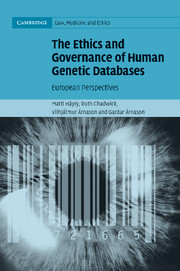Book contents
- Frontmatter
- Contents
- List of contributors
- 1 Introduction: some lessons of ELSAGEN
- Part I Background
- 2 On human genetic databases
- 3 American principles, European values and the mezzanine rules of ethical genetic databanking
- 4 The languages of privacy
- Part II Social concerns
- Part III Legal issues
- Part IV Ethical questions
- Part V Political considerations
- Part VI Conclusion
- Bibliography
- Index
4 - The languages of privacy
from Part I - Background
Published online by Cambridge University Press: 05 August 2012
- Frontmatter
- Contents
- List of contributors
- 1 Introduction: some lessons of ELSAGEN
- Part I Background
- 2 On human genetic databases
- 3 American principles, European values and the mezzanine rules of ethical genetic databanking
- 4 The languages of privacy
- Part II Social concerns
- Part III Legal issues
- Part IV Ethical questions
- Part V Political considerations
- Part VI Conclusion
- Bibliography
- Index
Summary
There has been a growing concern for privacy among the general public in the past decades. In Western societies this, paradoxically, is because the public senses both more and less privacy than before. On the one hand, people can enjoy more privacy and are more aware of privacy issues than before. With growing wealth, bigger houses and apartments people have more private space. Furthermore there is an increasing awareness of individual rights such as freedom and autonomy, which means people can have more control over their lives and their fate. On the other hand, there is less privacy in modern societies or more possibilities of threats to individual privacy. Various technological inventions, most recently information technology, magnify the possibilities of surveillance and intrusion into individual lives.
In light of this, it may not come as a surprise that scholarly discussion of privacy is fairly recent. In fact we can date the beginning of the discussion to the year 1890 with the publication of Warren and Brandeis' paper ‘The Right to Privacy’. The article is believed to have been a reaction to instant photographs and mass-produced newspapers, a new technology of that time. There it was argued that even if privacy was not explicitly expressed in the US Constitution or Bill of Rights, it was to be found there implicitly.
Information
- Type
- Chapter
- Information
- The Ethics and Governance of Human Genetic DatabasesEuropean Perspectives, pp. 37 - 42Publisher: Cambridge University PressPrint publication year: 2007
